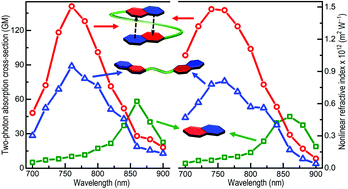Effect of spatial folding of molecules on two-photon absorption and nonlinear refraction in foldamers†
Abstract
The role of spatial folding of molecules on their nonlinear optical (NLO) properties such as two-photon absorption (TPA) and self-focusing due to nonlinear refraction (NR) has been studied experimentally on a newly designed foldamer (F1) having a centrosymmetric D–π–A–π–D structure. NLO studies by open- and closed-aperture z-scan measurements on F1 in methanol as well as in DMSO showed about 60% (90%) enhancement of the TPA (NR) coefficient over the value achieved for F1 in DMF. Studies by circular-dichroism spectroscopy, luminescence quenching in solvent-denaturation experiments, and nuclear Overhauser effect correlations in 2D NMR spectroscopy suggested that in methanol and in DMSO, F1 adopts a folded conformation driven by the solvophobic interactions favoring π-stacking of the aromatic units. F1 remains in the unfolded state in DMF. The enhancement of NLO coefficients for F1 in methanol as well as in DMSO may be attributed to the intramolecular cooperative interactions of π-stacked aromatic units of F1 in the folded conformation. The link between the spatial folding of F1 and its enhanced NLO properties is further ascertained when a gradual suppression of the folded conformation by adding trinitrophenol to the DMSO solution of F1 led to a correlated reduction of both the TPA and NR coefficients up to the level observed for F1 in DMF where F1 is in the unfolded state. Submillisecond time-resolved z-scan measurements revealed the thermal-lensing effect arising from strong TPA as the origin of the large NR index. Simultaneous enhancement of TPA and NR in the 700–900 nm range achieved through solvent-dependent spatial folding of molecules is promising for the application of NLO effects in biological samples where spatial folding of molecules plays important roles.



 Please wait while we load your content...
Please wait while we load your content...